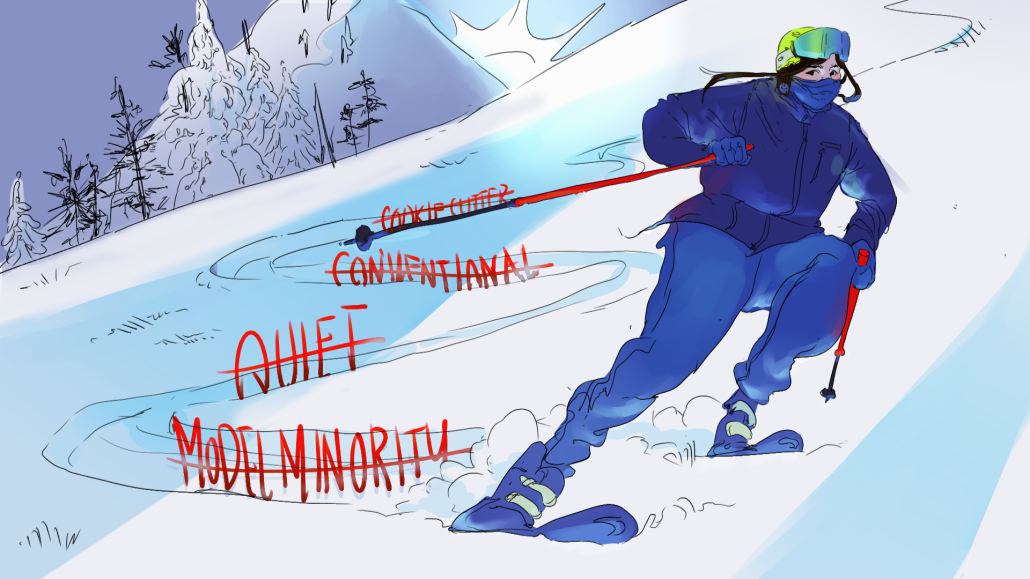Your College Unnie: I ski — Here’s why you should care

It’s a motion I’ve done hundreds of times before. Lunging forward onto the snow-swept platform, I wait for the familiar nudge of the chair and ascend into the mountains.
I fell in love with skiing when I was only 3 years old. No front teeth, Mount Bachelor, just good times. Every year since then, I’ve chased one thing: pow. From Beaver Creek to Whistler Blackcomb, if I was on skis, nothing else mattered.
This wasn’t always the case, though. Winter sports, such as skiing, and later snowboarding, have a history of being “as white as snow.” According to Ashley Rivas-Triana, a writer for the Emory University “History of Skiing and Snowsports” project, skiing was first introduced in the United States in the 19th century by Scandinavian immigrants. It was quickly popularized among Western mountain town residents, who used it as a form of efficient transportation. However, it also evolved to become a symbol of exclusive, elite white wealth.
American ski culture, Annie Gilbert Coleman notes in “The Unbearable Whiteness of Skiing,” “eventually lumped all Europeans and Scandinavians together under a lily-white ‘European’ image,” synonymizing whiteness with wealth, luxury, and exclusivity. In other words, ski culture, rather than emphasizing pow and the outdoors, adopted an image that revolved around ethnicity and class.
Despite decades of shredding, diversifying skiing is still a process today. According to the National Ski Areas Association annual demographic study, 5.7% of skiers in the 2021-22 season identified as Asian or Pacific Islander while 88.7% identified as white. The percentage of white skiers is actually an increase from the previous season, when 87.6% of skiers were white, with similarly slight decreases in non-white visits. In fact, “none of the percentages have significantly changed in the past 10 seasons,” the study read.
Growing up, I looked up to skiers like Lindsey Vonn and Mikaela Shiffrin. Of course they’re amazing athletes, but at the time, it didn’t seem like I had any other options.
There wasn’t really anyone that looked like me who I could look up to.
Now, it’s a little different. Bit by bit, snow sports are becoming more diverse and inclusive.
At age 14, Torrance native Chloe Kim won gold in SuperPipe at the 2015 X Games, becoming the youngest to do so in X Games history. She clinched gold again the following year, became the first female snowboarder to stomp back-to-back 1080s in the US Snowboarding Grand Prix and garnered a total of six SuperPipe Winter X titles. At the 2016 Lillehammer Winter Youth Olympic Games, Kim won gold in halfpipe and slopestyle.
Eileen Gu, a 19-year-old San Francisco native, won gold in freestyle halfpipe and big air at the recent 2022 Beijing Winter Olympics.
At the 2022 World Junior Alpine Ski Championships, Colorado native Ava Sunshine Jemison clinched a silver in Super-G and the 2022 Nor-Am overall title.
In early 2022, then 16-year-old Japanese snowboarder Hiroto Ogiwara stomped the first ever backside Quint Coke 2160 (six full rotations) in history at The Nines in Switzerland. Spinning a horizontal hexagon and vertical quintuple, this was the trick that put the Red Bull athlete on the map.
While it seems like there is an abundance of young talent, vying for a spot at the table as an Asian athlete is still an uphill battle — especially if you’re a woman.
Sung Yeon Choimorrow, the executive director of the National Asian Pacific American Women’s Forum, put it best.
“I’m really wrestling with this idea that we’re all ‘American’ only when it comes to us being excellent and winning medals for the country.”
The daughter of first-generation Korean immigrants, Kim became the youngest halfpipe gold medalist at the 2018 Winter Olympics in Pyeongchang. The following year, Kim defended her previous win as “the first woman to ever win multiple gold medals in the women’s event” since its introduction in 1998. Kim is the first athlete in history to clinch four major snowboarding titles in the Olympics, Worlds, Youth Olympics and X Games.
Yet, upon making the 2018 Olympic team, as an athlete and Asian American, Kim struggled with her identity.
“People started asking me about my identity and my story growing up as a Korean American,” Kim said in an interview with ESPN. “By that point, racism towards Asians had become so normalized, people would say racist things to me as jokes and I would just laugh because I didn’t want to deal with the confrontation and say, ‘That really bothered me.’”
Today, Kim is proud to be Korean American and stresses the need for having difficult conversations, especially those that involve racism.
“I hope that maybe one day, a little girl can hear my story and be inspired to keep going, to never give up, to learn that it’s OK to have a bad day, but you can move on if you come out in a better place at the end of it all,” Kim said.
The mountains may be the same, but slowly, things are changing.
It’s a bluebird day. Peering at the slope below, I slip on my goggles and push off on one ski. Gliding along the snow’s surface, as I gain speed, I lean into the mountain. I settle into a familiar, effortless pattern, leaving snake tracks in my wake.
I do this again and again, run after run, year after year.
I am carving out my own path.
You should too.
Victoria Lee is a freshman writing about the AAPI experience in America. She is also the Wellness and Community Outreach Director for the Daily Trojan. Her column, “Your College Unnie,” runs every other Wednesday.

